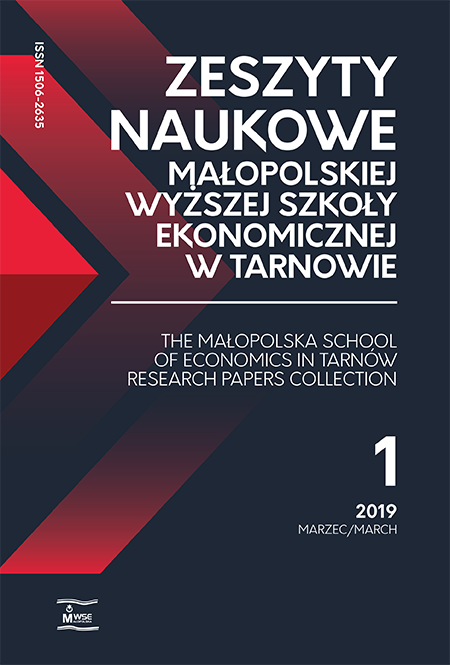Abstract
New technologies have an increasing, direct and indirect, impact on logistics within the framework of logistic processes, implying by this the constant evolution of logistics and future challenges. To phenomena that influence the transformation of logistics, can be classified the ones connected with the economic development in the world and Era of Digitalization, combined with the Fourth Technological Revolution, which cause transformations in the extent of cooperation between enterprises and controlling the processes in the supply chain, both on enterprises’ and sectors’ scale. The blockchain is placed on the list of ten technologies, that have the biggest potential to change the face of business, work style, values hierarchy. The aim of this article is to present the blockchain technology, that may have a revolutionary importance in logistics. It can fasten and ease many logistic processes providing them with the common, undeniable source of information, ensuring the new level of transparency and safety in the supply chain. It lays the foundation for creating logistics based on the Internet of Things (IoT), cloud computing and artificial intelligence (AI), including smart contracts. The article points out phenomena that generate challenges for the logistics, and describes what the blockchain is and why is it worth to benefit from it referring to its features, pros and cons. Given practical examples concerns the usage of discussed technology in logistics.
References
Cann, O. (2016). These are the top 10 emerging technologies of 2016 [online, dostęp: 2018-03-15]. World Economic Forum. Dostępny w Internecie: https://www.weforum.org/agenda/2016/06/top-10-emerging-technologies-2016/.
View in Google Scholar
Coyle, J.J., Bardi, E.J., Langley, C.J. (2010). Zarządzanie logistyczne. Warszawa: Polskie Wydawnictwo Ekonomiczne. ISBN 9788320818642.
View in Google Scholar
Deloitte. (2017). Technologia Blockchain i jej potencjał w podatkach [online, dostęp: 2018-04-14]. Warszawa: Deloitte Polska. Dostępny w Internecie: https://www2.deloitte.com/content/dam/Deloitte/pl/Documents/Reports/pl_Blockchain-technology-and-its-potential-in-taxes-2017-PL.PDF.
View in Google Scholar
Dörner, K., Edelman, D. (2015). What ‘digital’ really means [online, dostęp: 2018-02-15]. McKinsey Digital. Dostępny w Internecie: https://www.mckinsey.com/industries/high-tech/our-insights/what-digital-really-means.
View in Google Scholar
Emst, P. van. (2017). Please tell me, what is blockchain and how does it work? [online, dostęp: 2018-03-15]. LinkedIn. Dostępny w Internecie: https://www.linkedin.com/pulse/please-tell-me-what-blockchain-howdoes-work-peter-van-emst.
View in Google Scholar
Forbes Insights. (2016). Doing Business In-the-Moment: Transforming Transaction Processing for Digital Economy. Briefing Report [online, dostęp: 2017-11-20]. Dostępny w Internecie: https://www.sap.com/documents/2017/01/e443cf0b-a37c-0010-82c7-eda71af511fa.html.
View in Google Scholar
Jędrzejczyk, M., Marzantowicz, K. (2016). Blockchain jest fundamentem cyfrowej gospodarki opierającej się na współpracy: rozmowa z Maciejem Jędrzejczykiem i Karoliną Marzantowicz z IBM [online, dostęp: 2018-02-15]. Rozmawiał J. Czarnecki. W: Blockchain, inteligentne kontrakty i DAO (s. 26–29). Warszawa: Wardyński i Wspólnicy. Dostępny w Internecie: http://www.codozasady.pl/wp-content/uploads/2016/10/Wardynski-i-Wspolnicy_-Blockchain-inteligentne-kontrakty-i-DAO.pdf.
View in Google Scholar
Jurczak, M. (2018). Blockchain „czarnym koniem” logistyki? [online, dostęp: 2018-04-20]. Trans.info Polska. Dostępny w Internecie: https://trans.info/blockchain-czarnym-koniem-logistyki-83455.
View in Google Scholar
Klinger, B., Szczepański, J. (2017). Blochchain – historia, cechy i główne obszary zastosowań. Człowiek w Cyberprzestrzeni, 1, 11–27.
View in Google Scholar
Kõlvart, M. (2016). Smart contracts. W: T. Kerikmäe, A. Rull (eds.). The Future of Law and eTechnologies (s. 133–147). Switzerland: Springer International Publishing. ISBN 9783319268941.
View in Google Scholar
Kurpas, M. (2018). Samsung używa blockchainu, aby zmniejszyć koszty wysyłki o 20%. [online, dostęp: 2018-04-20]. Cryptodemy. Dostępny w Internecie: https://cryptodemy.pl/samsung-uzywa-blockchainu-abyzmniejszyc-koszty-wysylki-o-20/.
View in Google Scholar
Manyika, J., Chui, M., Bughin, J., Dobbs, R., Bisson, P., Marrs, A. (2013). Disruptive technologies: Advances that will transform life, business, and the global economy [online, dostęp: 2018-03-15]. Raport McKinsey Global Institute. McKinsey & Company. Dostępny w Internecie: https://www.mckinsey.com/~/media/McKinsey/Business%20Functions/McKinsey%20Digital/Our%20Insights/Disruptive%20technologies/MGI_Disruptive_technologies_Full_report_May2013.ashx.
View in Google Scholar
Marciniak, M. (2016). Istotne ograniczenia Blockchain w zastosowaniach komercyjnych [online, dostęp: 2018-04-20]. Magazyn iTWIZ, 9. Dostępny w Internecie: https://itwiz.pl/istotne-ograniczeniablockchain-zastosowaniach-komercyjnych/.
View in Google Scholar
Mell, P., Grance, T. (2011). The NIST Definition of Cloud Computing. Recommendations of the National Institute of Standards and Technology [online, dostęp: 2017-12-07]. Gaithersburg: National Institute of Standards and Technology. Dostępny w Internecie: https://nvlpubs.nist.gov/nistpubs/Legacy/SP/nistspecialpublication800-145.pdf.
View in Google Scholar
Miller, M. (2016). Internet rzeczy: jak inteligentne telewizory, samochody, domy i miasta zmieniają świat. Warszawa: Wydawnictwo Naukowe PWN. ISBN 9788301185282.
View in Google Scholar
Paprocki, W. (2016). Koncepcja Przemysł 4.0 i jej zastosowanie w warunkach gospodarki cyfrowej. W: J. Gajewski, W. Paprocki, J. Pieriegud (red.). Cyfryzacja gospodarki i społeczeństwa. Szanse i wyzwania dla sektorów infrastrukturalnych (s. 39–57). Gdańsk: Instytut Badań nad Gospodarką Rynkową; Gdańska Akademia Bankowa. ISBN 9788388835285.
View in Google Scholar
Piech, K. (red.). (2016). Leksykon pojęć na temat technologii blockchain i kryptowalut. Warszawa: Ministerstwo Cyfryzacji.
View in Google Scholar
Piech, K. (red.). (2017). Podstawy korzystania z walut cyfrowych. Warszawa: Instytut Wiedzy i Innowacji. ISBN 9788360653289.
View in Google Scholar
Pluralsight. (2018). Technology in 2025: Prepare for the fourth industrial revolution [online, dostęp: 2018-03-28]. Pluralsigh. Dostępny w Internecie: https://www.pluralsight.com/blog/career/tech-in-2025.
View in Google Scholar
Schwab, K. (2016). The Fourth Industrial Revolution. Cologny/Geneva: World Economic Forum. ISBN 9781944835002.
View in Google Scholar
Sędziak, P. (2018). Supply chain i blockchain – czy warto myśleć o ich syntezie? [online, dostęp: 2018-04-20]. Logistyka a Jakość, 1, 46–50. Dostępny w Internecie: http://laj.pl/zarzadzanie/3973/supply-chain-iblockchain-czy-warto-myslec-o-ich-syntezie/.
View in Google Scholar
Still. (2018). Przemysł 4.0 – przyszłość czy mrzonka? [online, dostęp: 2018-04-04]. Still Polska. Dostępny w Internecie: http://www.still.pl/28657.0.0.html.
View in Google Scholar
Szukalski, S.M., Wodnicka, M. (2016). Outsourcing. Metodyka przygotowywania procesów i ocena efektywności. Warszawa: Difin. ISBN 9788380851481.
View in Google Scholar
World Economic Forum. (2016a). The Future of Jobs: Employment, Skills and Workforce Strategy for the Fourth Industrial Revolution [online, dostęp: 2018.03.15]. Cologny/Geneva: World Economic Forum. Dostępny w Internecie: http://www3.weforum.org/docs/WEF_Future_of_Jobs.pdf.
View in Google Scholar
World Economic Forum. (2016b). Top 10 Emerging Technologies of 2016 [online, dostęp: 2018-03-15]. Cologny/Geneva: World Economic Forum. Dostępny w Internecie: http://www3.weforum.org/docs/GAC16_Top10_Emerging_Technologies_2016_report.pdf.
View in Google Scholar
© Copyright by Małopolska School of Economics in Tarnów. The articles are available under the Creative Commons Attribution NonCommercial-NoDerivatives 4.0 International License


